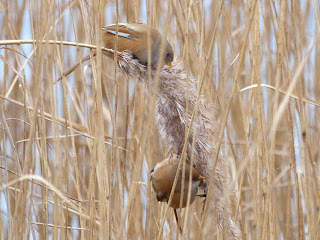Sunday, 3 February 2013
Sunday brought a lot of photographers for the Bearded Tits, who were obligingly present ...
... and for the Tawny Owl, who wasn't. Probably he is just staying inside the nest tree, but it is impossible to tell until someone sees him again. Last year, not long before the owlets were due to emerge, he vanished for a long time and people feared that he had been killed by eating poisoned rats -- idiotically, the park management had put rat poison out in his hunting area. But then he was found, with the owlets, in a tree 200 yards away. It is quite possible that he is spending the day in an outlying place that simply hasn't been spotted.
Apart from that, it was a very ordinary day with the usual birds in their usual places, and very little to report. But, as I was walking through a crowd of pigeons of every possible colour, I thought of an interesting article I had read in the January issue of British Birds, 'Colour aberrations in birds' by Hein van Grouw.
He distinguishes seven different common aberrations, all caused by abnormal amounts of the two kinds of the pigment melanin that give birds' feathers their black or brown colours: eumelanin, which is black, and phaeomelanin, which is reddish-brown. They do not affect the bright red, orange and yellow colours, which are due to carotene pigments.
1. Albinism: no melanins at all. Bird has pink eyes and poor eyesight, selom lives long in the wild.
2. Leucism: total lack of melanins in some feathers. Bird has a pied appearance. Often the white patches are fairly symmetrical.
3, Progressive greying: gradual loss of melanins in some feathers, often due to age. Bird has a speckled appearance.
4. Brown: black eumelanin reduced, so that the reddish phaeomelanin shows through. Bird looks brown.
5. Dilution: reduction of either melanin to some extent. If both are equally reduced, bird is 'pastel', if eumelanin is reduced more, bird is 'isabel', pale brown.
6. Ino: both melanins strongly reduced. Bird is pale and has pink bill and feet; in the lightest kinds it has pinkish eyes, though not as pink as those of an albino.
7. Melanism: higher than usual levels of melanins. Bird is darker than normal, even black.
One of the commonest examples of leucism is seen in Blackbirds. Here is a completely pied one, photographed a few years ago in the leaf yard.
Crows are also often affected by leucism, but this young crow has white flight feathers with black tips, and these have a different cause: a period of malnutrition while the feathers were developing. A shorter period of malnutrition would have produced a narrower white band.
This crow, one of a family on the Vista, is rather undersized. It has a sibling that is of normal size and colour. I don't know how it came to be malnourished, but it is definitely bullied by the rest of the family.
Here are eight small pictures of pigeons, all photographed within a hundred yards of each other beside the Serpentine. Urban pigeons are descended from the Rock Dove, Columba livia. In the wild, all Rock Doves are the same colour, pale grey with two noticeable dark wing bars, like the one in the first picture. But somehow when they came to town the colour mechanism broke down in every conceivable way.
The last bird is not an albino, as it has dark eyes. It also has a few dark tail feathers. This is an extreme example of leucism.
Subscribe to:
Post Comments (Atom)











No comments:
Post a Comment